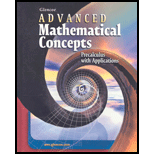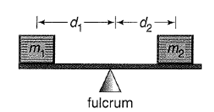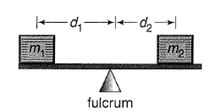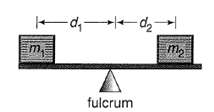
Concept explainers
(a)
To find: The type of variation that describes the relationship between torque, mass and distance. Explain.
(a)
Answer to Problem 35E
Explanation of Solution
Given information: Physics: If you have observed people on a seesaw, you may have noticed that the heavier person must sit closer to the fulcrum for the seesaw to balance. In doing so, the heavier participant creates a rotational force, called torque. The torque on the end of a seesaw depends on the mass of the person and his or her distance from the seesaw’s fulcrum. In order to reduce torque, one must either reduce the distance between the person and the fulcrum or replace the person with someone having a smaller mass.

Calculation:
T varies jointly as D and M
(b)
To derive: An equation that represents this seesaw in balance, if
(b)
Answer to Problem 35E
Explanation of Solution
Given information: Physics: If you have observed people on a seesaw, you may have noticed that the heavier person must sit closer to the fulcrum for the seesaw to balance. In doing so, the heavier participant creates a rotational force, called torque. The torque on the end of a seesaw depends on the mass of the person and his or her distance from the seesaw’s fulcrum. In order to reduce torque, one must either reduce the distance between the person and the fulcrum or replace the person with someone having a smaller mass.

Calculation:
In order for the seesaw to be in balance, the Force on the left side must equal the force on the other side.
F = (mass) (distance from fulcrum)
(c)
To find: The distance the babysitter should sit from the pivot in order to balance the seesaw using the equation found in part b, is a 75-pound child and a 125-pound babysitter sit at either end of a seesaw. The child sits 3.3 meters from the fulcrum.
(c)
Answer to Problem 35E
Explanation of Solution
Given information: Physics: If you have observed people on a seesaw, you may have noticed that the heavier person must sit closer to the fulcrum for the seesaw to balance. In doing so, the heavier participant creates a rotational force, called torque. The torque on the end of a seesaw depends on the mass of the person and his or her distance from the seesaw’s fulcrum. In order to reduce torque, one must either reduce the distance between the person and the fulcrum or replace the person with someone having a smaller mass.

Calculation:
T varies jointly as D and M
Replace the values of T, K, M in the equation to find distance D
Chapter 3 Solutions
Advanced Mathematical Concepts: Precalculus with Applications, Student Edition
Additional Math Textbook Solutions
University Calculus: Early Transcendentals (4th Edition)
Calculus: Early Transcendentals (2nd Edition)
University Calculus: Early Transcendentals (3rd Edition)
Single Variable Calculus: Early Transcendentals (2nd Edition) - Standalone book
Calculus: Early Transcendentals (3rd Edition)
 Calculus: Early TranscendentalsCalculusISBN:9781285741550Author:James StewartPublisher:Cengage Learning
Calculus: Early TranscendentalsCalculusISBN:9781285741550Author:James StewartPublisher:Cengage Learning Thomas' Calculus (14th Edition)CalculusISBN:9780134438986Author:Joel R. Hass, Christopher E. Heil, Maurice D. WeirPublisher:PEARSON
Thomas' Calculus (14th Edition)CalculusISBN:9780134438986Author:Joel R. Hass, Christopher E. Heil, Maurice D. WeirPublisher:PEARSON Calculus: Early Transcendentals (3rd Edition)CalculusISBN:9780134763644Author:William L. Briggs, Lyle Cochran, Bernard Gillett, Eric SchulzPublisher:PEARSON
Calculus: Early Transcendentals (3rd Edition)CalculusISBN:9780134763644Author:William L. Briggs, Lyle Cochran, Bernard Gillett, Eric SchulzPublisher:PEARSON Calculus: Early TranscendentalsCalculusISBN:9781319050740Author:Jon Rogawski, Colin Adams, Robert FranzosaPublisher:W. H. Freeman
Calculus: Early TranscendentalsCalculusISBN:9781319050740Author:Jon Rogawski, Colin Adams, Robert FranzosaPublisher:W. H. Freeman
 Calculus: Early Transcendental FunctionsCalculusISBN:9781337552516Author:Ron Larson, Bruce H. EdwardsPublisher:Cengage Learning
Calculus: Early Transcendental FunctionsCalculusISBN:9781337552516Author:Ron Larson, Bruce H. EdwardsPublisher:Cengage Learning





